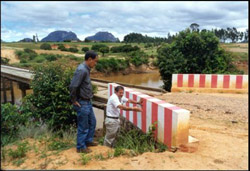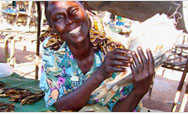
Photo: Sally Cameron
Workers in Madagascar protect roads and bridges from erosion.
“Lower transportation costs mean more money for us and more rice for the price for consumers.”
- Ralaiyao Marcel, teacher, road association officer & rice grower.
|
Initiative
USAID rehabilitated 460 km of farm-to-market and secondary roads. As part of this program, farmers and community members formed road-user associations in partnership with local authorities, village groups, and private sector agribusinesses.
These associations manage and maintain the rebuilt roads with funding from users, local governments, and private enterprises. USAID specialists are helping farmers obtain tools and improved seeds from farm supply stores, and providing assistance in fighting rice disease using methods that do not harm the environment.
|


